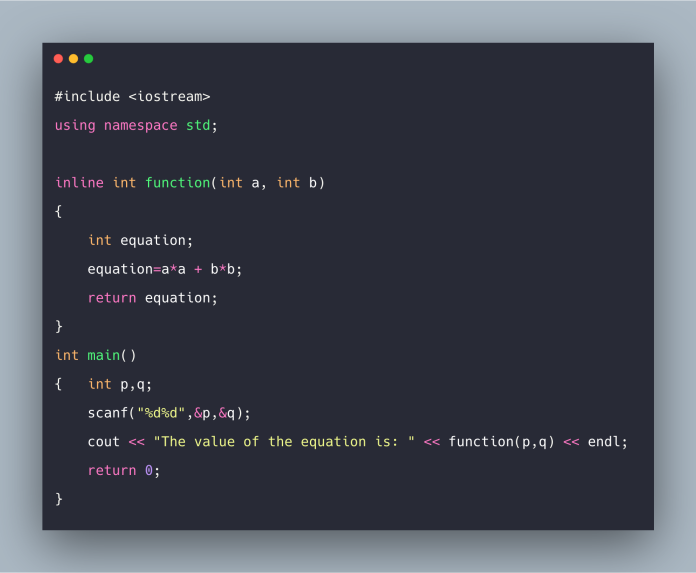What is C++ | Inline function in C++. In C++, an inline function is a special type of function that is expanded directly by the compiler at the point of call rather than being executed as a separate function.
As the function’s code is inserted directly into the calling code, this can improve the performance of your program by reducing the overhead of function calls.
The “inline” keyword is used in the definition of inline functions, which are typically used for small, frequently-used functions that require a simple implementation. The purpose of this article is to discuss the Inline function in C++
Table of Contents
Introduction
A C++ inline function is expanded in-line by the compiler at the point where it is called, rather than being executed separately.
Inline functions are defined with the “inline” keyword and can be used to reduce the overhead of function calls in a program to improve performance.
Typically, they are used for small, frequently called functions that are easy to implement. Although inline functions can be useful optimization techniques, overuse can result in larger programs and slower performance overall.
What is C++?
Programming in C++ is a high-performance language used in a variety of fields, such as operating systems, games, and desktop applications.
As an extension of the C programming language, it was developed by Bjarne Stroustrup in 1979.
The C++ programming language is an object-oriented programming language, which allows developers to create and manipulate objects within their programs.
Moreover, it supports procedural programming, which involves breaking down a program into smaller functions that can be called as needed.
Example
Here is a simple C++ program that prints “Hello, World!” to the console
#include <iostream>
int main()
{std::cout << “Hello, World!” << std::endl;
return 0;}
What is an inline function in C++?
Inline functions are functions that are expanded in line when called, rather than using the usual function call mechanism.
Due to the elimination of function call overhead, this can potentially result in faster code execution.
-
Declare an inline function in C++
In C++, you can declare an inline function by using the inline keyword before the function’s return type.
Example
inline int add(int a, int b)
{return a + b;}
When to use inline functions in C++?
The use of inline functions can be advantageous in situations where the function is small and is frequently called.
The reason for this is that by expanding the function inline, the overhead of the function calls may be eliminated, resulting in faster execution of the code.
The use of inline functions, however, may not always be advantageous and may sometimes result in larger code sizes and slower performance.
-
Advantages of using inline functions in C++
Some potential advantages of using inline functions in C++ include:
- Improved performance: The elimination of the function call overhead may allow inline functions to result in faster code execution.
- Reduced code size: As the function code is expanded inline rather than being called through a function call mechanism, inline functions can potentially reduce the overall code size.
-
Disadvantages of using inline functions in C++
Some potential disadvantages of using inline functions in C++ include:
- Increased code size: When inline functions are used, the code is expanded inline rather than being called through a function call mechanism.
- Decreased performance: The use of inline functions can sometimes result in slower code execution, as the expanded function code may not be as optimized as the call mechanism.
How to force a function to be inline in C++?
In C++, the inline keyword can be used before the return type of a function to force it to be inlined.
The compiler will expand the function inline rather than calling it through the usual function call mechanism when it is called.
The compiler, however, may still decide not to inline the function based on its optimization criteria.
How to prevent a function from being inline in C++?
To prevent a function from being inline in C++, you can use the “noinline” attribute.
Example
[[noinline]] void foo()
{// function code here}
This tells the compiler to not expand the function inline when it is called and to call it through the usual function call mechanism instead.
Inline function vs. macro in C++
Functions and macros are both mechanisms for expanding code inline, but they differ in several important ways:
- The compiler treats inline functions as regular functions and performs type checking and other compile-time checks on them.
- As opposed to macros, which are simple text replacements, macros are not subject to the same checks.
- The inline functions can have a return type and accept arguments, whereas macros can only replace text.
Conclusion
Programmers use C++ to develop a wide range of applications, including operating systems, web browsers, and games. In C++, an inline function is a function that is called directly rather than using the normal function call mechanism.
Due to the elimination of the function call overhead, this may result in faster code execution. However, inline functions are not always beneficial, and can sometimes result in larger code sizes and slower performance.
Inline functions are most useful when the function is small and called frequently, and can be declared by putting the inline keyword before the function’s return type.









